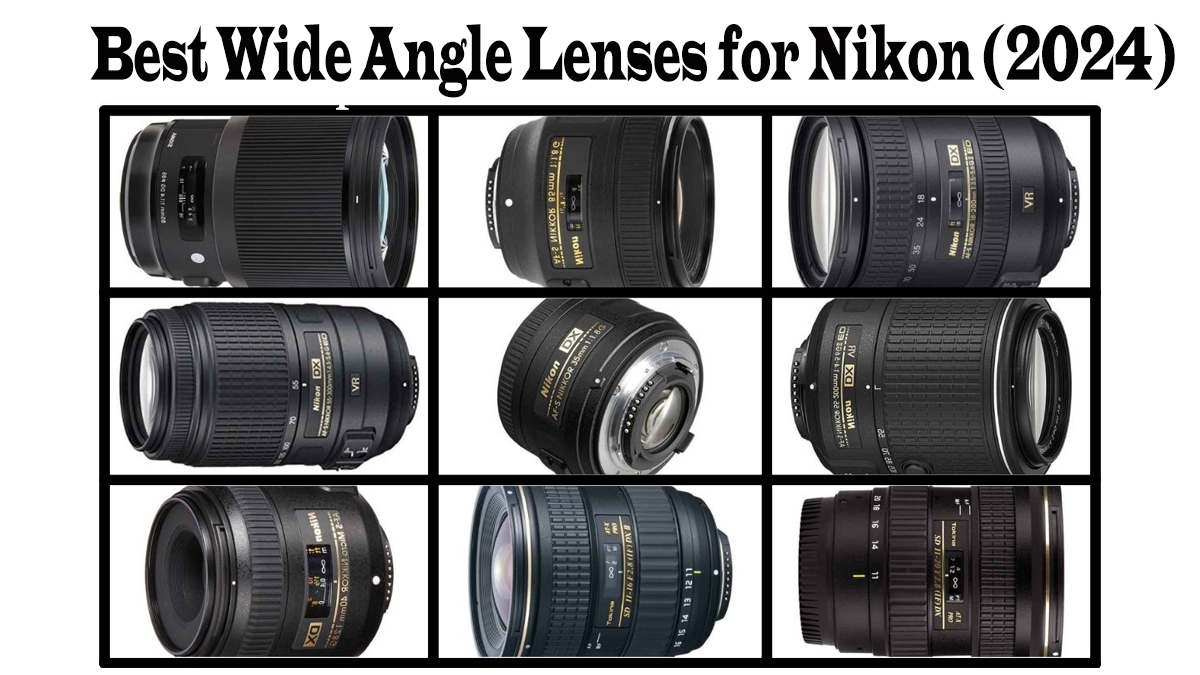Best Wide Angle Lenses for Nikon: Welcome to a world full of beautiful scenery and wide open areas, where each and every detail is important. There you are, Nikon fans! You’ve found the right place to find the best wide-angle lens to make your photos better. In this detailed guide, we’ll talk about the best wide-angle lenses made just for Nikon cameras. These lenses will let you take stunning photos with the highest level of clarity and accuracy.
It took me a few years to get used to wide angle lenses, but now I relish using them. Since I was a Nikon shooter, I had a lot of options, but none of them seemed to work well for my needs. If that sounds like you and you often look at things from a big picture point of view, this post might help you make a decision.
Over the last few years, I’ve tried out a lot of third-party wide-angle lenses as well as almost all of Nikon’s current wide-angle lenses. When we did our many reviews of camera man life, Nasim did even more tests. One thing that stays the same is being ready to settle. There is no perfect wide view. But as time goes on, things get better, and some of the new options are truly breathtaking.
Here is a list of the twenty five best wide-angle lenses for Nikon full-frame cameras. (There is a part at the bottom for people who use Nikon DX cameras.) As you might expect, this kind of list is limited by the author’s choices. There would be fewer wide angles available from lens makers if there was a single best wide angle for everyone.
Table of Contents
First things first: these are the things I thought were most important when I graded the lenses below, in order:
- Overall quality of Images: Image quality determines everything, including distortion and sharpness. If a lens fails all optical tests, few photographers would purchase it, even if it excels in every other regard.
- Price: For the majority of us, the cost (or, maybe more precisely, the value) of the lens comes in second to picture quality as a possible deal breaker. Wide perspectives include a broad spectrum of costs. The prices of the lenses below range from $290 at the lowest price to $1900 at the highest.
- Size: Large angle lenses may become bulky. Some of them easily top 1 kilogram (2.2 pounds) in weight, weighing in at par with telephotos. For many travel and nature photographers, a lightweight lens is just essential.
- capability of Filter : It’s not always possible to screw in a filter at the front of a wide-angle lens. You’ll need to buy a big, pricey adapter and bigger, more expensive filters in order to use filters with lenses that don’t have threads.
- Autofocus vs manual focus: Three of the thirteen lenses on this list can only be focused by hand. That saves money and weight most of the time, and for many wide angle shots, manual focus isn’t the end of the world. Still, if everything else is the same, most shooters also like the choice of autofocus.
- Focal length(s):I call anything 24mm or wider “wide angle,” but all of these lenses are at least a bit wider than that. Any lens that goes up to 14mm or 15mm and any zoom that has a “telephoto” range that is longer than expected get extra points from me.
- Maximum aperture: This function is only really useful for astrophotographers, which is a big group of wide-angle makers. More light can be collected by lenses with apertures of f/2.8 or bigger than by f/4 lenses. This makes the Milky Way brighter and less noisy.
Best Wide Angle Lenses for Nikon
25. Zeiss Milvus 21mm f/2.8

The Zeiss Milvus 21mm f/2.8 is a wide-angle prime lens made by the well-known German optics company Carl Zeiss AG. The last time I checked, in January 2022, the Milvus line was known for having great optical performance and build quality.
Key features of the Zeiss Milvus 21mm f/2.8 lens include:
- Focal Length: 21mm: This makes it a wide-angle lens that can be used for building, landscapes, and other situations where you want a wider view.
- Aperture: f/2.8 – The highest aperture of f/2.8 is pretty wide, which lets you get creative with depth of field and good performance in low light.
- Optical Design: Zeiss lenses are known for how well they work with light. It’s possible that the Milvus 21mm f/2.8 has high-quality glass elements and modern lens coatings that keep flare, distortion, and other issues to a minimum.
- Build Quality: Zeiss lenses are usually well-made, and they are usually made of metal, which lasts a long time. In particular, the Milvus line is known for being well-made and immune to the weather.
- Manual Focus: A lot of Zeiss lenses have adjustable focus controls, which can help you get the focus just right in some cases, like when you’re taking pictures of landscapes or buildings..
- Compatibility: The lens might work with different camera systems, like Canon EF, Nikon F, and more, depending on the mount type.
Please keep in mind that lens specs can change, and new types may have come out since my last update in January 2022. Checking Zeiss’s website or reading recent reviews and product paperwork are the best ways to get the most up-to-date and complete information.
- Also Read
- Best Lenses for Nikon d3300 on the Market 2024
- 5 Best Mirrorless Cameras Under $1,000 in 2024
- Sony Alpha 6600 vs Fujifilm XT-4: In 2024, Which is the best?
- 5 Best Panasonic Cameras in 2024
24. Samyang 14mm f/2.8
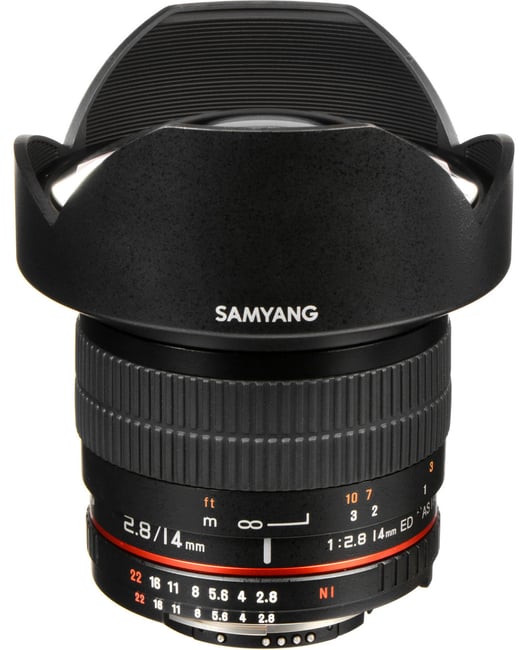
The Samyang 14mm f/2.8 was a wide-angle prime lens made by Samyang Optics, a South Korean company known for making many lenses, some of which are manual focus and some of which fit different camera types. These are some of the most important things about the Samyang 14mm f/2.8 lens:
- Focal Length: 14mm – This makes it an ultra-wide-angle lens, suitable for capturing expansive landscapes, architecture, and astrophotography.
- Aperture: f/2.8 – The wide aperture allows for good low-light performance and the ability to achieve a shallow depth of field, although ultra-wide lenses are often used to capture scenes with a broader depth of field.
- Manual Focus: Many Samyang lenses, including the 14mm f/2.8, are manual focus lenses. This means that users have to manually adjust the focus, which can be preferred by some photographers, especially those involved in certain types of photography like astrophotography.
- Multi-Coating: Samyang lenses often come with multi-coating on the lens elements to reduce ghosting and flare, as well as to enhance contrast and color reproduction.
- Compatibility: The Samyang 14mm f/2.8 is available in various mounts, making it compatible with different camera systems such as Canon, Nikon, Sony, and more.
- Build Quality: Samyang lenses are known for offering good optical performance at a relatively affordable price point. The build quality is generally decent, but it may not be as robust as some higher-end lenses.
Please note that specifications and features can vary, and there may be updated versions or new models released since my last update. For the most accurate and recent information, it’s recommended to check the official Samyang website or consult reviews and product documentation.
23. Sigma 14mm f/1.8 Art
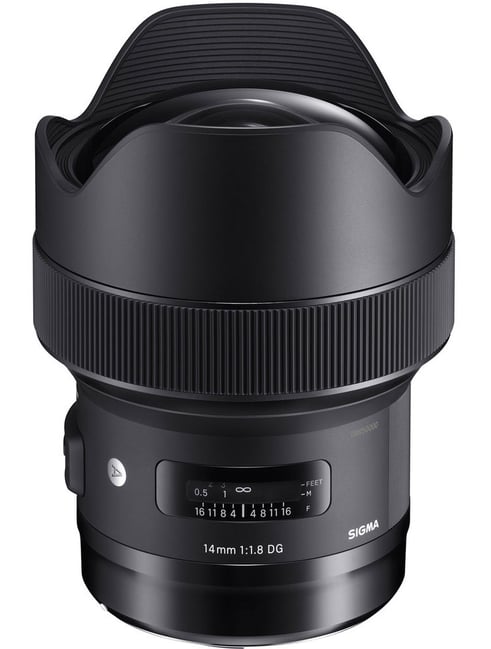
The Sigma 14mm f/1.8 DG HSM Art is a wide-angle prime lens designed and manufactured by Sigma Corporation, a Japanese company known for producing a wide range of lenses for various camera systems. Here are some key features of the Sigma 14mm f/1.8 Art lens:
- Focal Length: 14mm – This makes it an ultra-wide-angle lens, suitable for capturing expansive landscapes, architecture, and astrophotography.
- Aperture: f/1.8 – The wide maximum aperture of f/1.8 allows for excellent low-light performance and depth of field control. This is particularly beneficial for astrophotography and other low-light situations.
- Art Series: Sigma’s “Art” lenses are part of their high-performance lineup known for delivering exceptional optical quality and build. The Art series lenses are designed for professional use and are often praised for their image quality.
- Optical Design: The lens likely features advanced optics, including specialized glass elements and coatings, to minimize distortions, aberrations, and flare, and to produce sharp and clear images.
- Hyper Sonic Motor (HSM): The inclusion of Sigma’s HSM autofocus motor provides fast and quiet autofocus performance. However, it’s worth noting that Sigma’s Art series lenses may also offer full-time manual focus override for fine-tuning focus manually.
- Build Quality: Sigma Art lenses are known for their robust construction. The lens is likely made with high-quality materials and may feature weather-sealing to protect against dust and moisture.
- Compatibility: The lens is available in various mounts, making it compatible with different camera systems, such as Canon, Nikon, Sony, etc.
22. Rokinon 14mm f/2.4
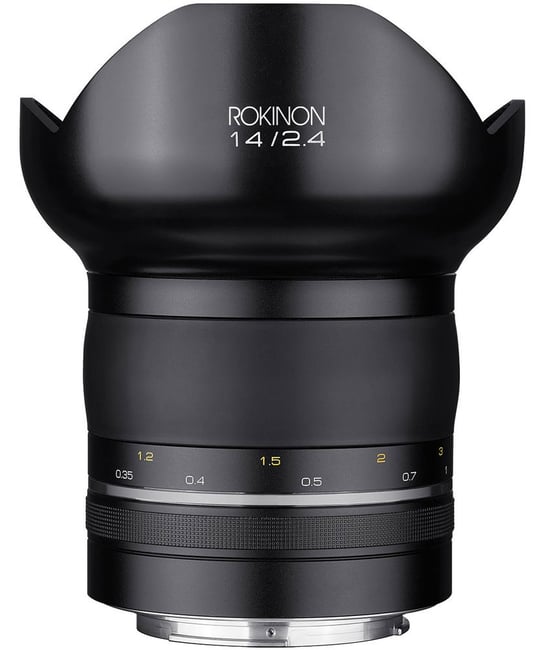
The Rokinon 14mm f/2.4 lens is part of Rokinon’s manual focus lineup designed for various camera mounts. Here are some key features of the Rokinon 14mm f/2.4 lens:
- Focal Length: 14mm – This makes it an ultra-wide-angle lens, suitable for capturing expansive landscapes, architecture, and astrophotography.
- Aperture: f/2.4 – The wide aperture of f/2.4 allows for good low-light performance and the ability to achieve a shallow depth of field, although ultra-wide lenses are often used for deep depth of field shots.
- Manual Focus: Rokinon lenses, including the 14mm f/2.4, are typically manual focus lenses. This means users need to manually adjust the focus ring to achieve sharp focus.
- Optical Design: The lens likely features multiple lens elements with specialized coatings to reduce distortions, aberrations, and improve image quality.
- Build Quality: Rokinon lenses are generally known for offering good optical performance at an affordable price point. The build quality is decent, but it may not be as robust as some higher-end lenses.
- Compatibility: The Rokinon 14mm f/2.4 is available in various mounts, making it compatible with different camera systems such as Canon, Nikon, Sony, and more.
- Weather Sealing: Some versions of Rokinon lenses may feature weather-sealing, providing additional protection against dust and moisture.
It’s important to note that specifications and features can vary between different versions of Rokinon lenses or across different mounts. For the most accurate and recent information, it’s recommended to check the official Rokinon website or consult reviews and product documentation specific to the particular model you are interested in.
21. Nikon 16-35mm f/4
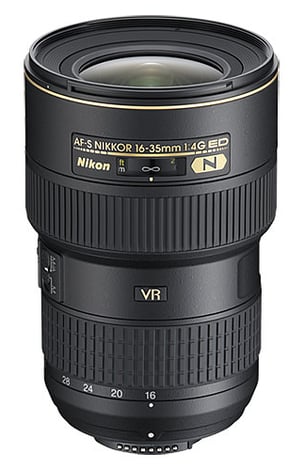
The Nikon AF-S NIKKOR 16-35mm f/4G ED VR is a wide-angle zoom lens designed for Nikon’s FX (full-frame) camera bodies. Here are some key features of the Nikon 16-35mm f/4 lens:
- Focal Length: The lens has a focal length range of 16-35mm, making it a versatile wide-angle zoom lens. It’s suitable for a variety of applications, including landscape, architecture, and interior photography.
- Aperture: The lens has a constant maximum aperture of f/4 throughout the zoom range. While f/4 is not as wide as some prime lenses, having a constant aperture is useful for consistent exposure settings when zooming in and out.
- Vibration Reduction (VR): The lens features Nikon’s Vibration Reduction technology, which helps to reduce the impact of camera shake, particularly in low-light situations or when using slower shutter speeds.
- ED (Extra-Low Dispersion) Glass: The inclusion of ED glass elements in the lens design helps to minimize chromatic aberrations and improve overall image quality.
- Nano Crystal Coat: Nikon’s Nano Crystal Coat is applied to reduce lens flare and ghosting, resulting in better contrast and color accuracy, especially in challenging lighting conditions.
- Silent Wave Motor (SWM): The lens is equipped with Nikon’s Silent Wave Motor for fast, accurate, and quiet autofocus.
- Weather Sealing: The lens may feature some level of weather sealing, providing protection against dust and moisture.
- Internal Focusing (IF): The lens likely features internal focusing, meaning the lens barrel does not extend during focusing, and the front element does not rotate. This can be beneficial when using polarizing filters.
- Compatibility: The lens is designed for Nikon’s F-mount, making it compatible with a range of Nikon DSLR cameras, both full-frame (FX) and APS-C (DX).
It’s always a good idea to check the latest specifications and reviews, as product details can change, and new models may be released after my last update. For the most accurate and recent information, refer to Nikon’s official website or consult with authorized dealers.
20.Nikon 18-35mm f/3.5-4.5
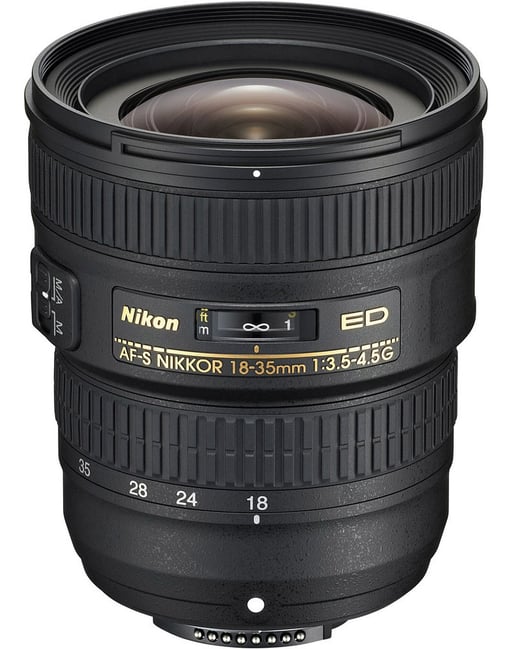
The Nikon AF-S NIKKOR 18-35mm f/3.5-4.5G ED is a wide-angle zoom lens designed for Nikon’s FX (full-frame) camera bodies. Here are some key features of the Nikon 18-35mm f/3.5-4.5 lens:
- Focal Length: The lens covers a focal length range of 18-35mm, providing a wide-angle to standard focal length, making it suitable for various photography genres, including landscapes and architecture.
- Variable Aperture: The lens has a variable maximum aperture, ranging from f/3.5 at 18mm to f/4.5 at 35mm. While it may not have a constant aperture, it still offers versatility for different shooting conditions.
- ED (Extra-Low Dispersion) Glass: The lens incorporates ED glass elements to reduce chromatic aberrations and enhance overall image quality.
- Aspherical Elements: Aspherical lens elements are often included to correct spherical aberrations and distortion, contributing to improved image sharpness.
- Silent Wave Motor (SWM): The lens features Nikon’s Silent Wave Motor for fast, accurate, and quiet autofocus performance.
- Internal Focusing (IF): The lens likely features internal focusing, meaning the lens length does not change during focusing. This can be advantageous when using polarizing filters.
- Super Integrated Coating (SIC): Nikon’s Super Integrated Coating is applied to reduce lens flare and ghosting while improving color and contrast.
- Compact and Lightweight Design: The lens is designed to be relatively compact and lightweight, making it a convenient option for photographers who value portability.
- Compatibility: The lens is designed for Nikon’s F-mount, making it compatible with a range of Nikon DSLR cameras, both full-frame (FX) and APS-C (DX).
It’s essential to check for any updates or new models that may have been released since my last update. For the most accurate and recent information, refer to Nikon’s official website or consult with authorized dealers.
19. Nikon 14-24mm f/2.8
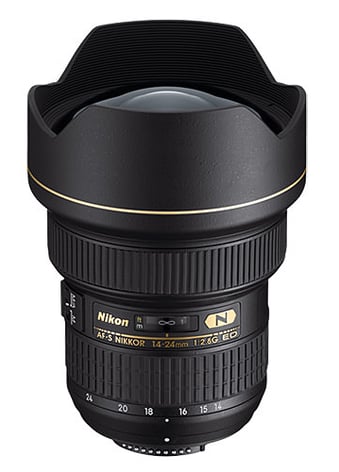
The Nikon AF-S NIKKOR 14-24mm f/2.8G ED is a wide-angle zoom lens designed for Nikon’s FX (full-frame) camera bodies. Here are some key features of the Nikon 14-24mm f/2.8 lens:
- Focal Length: The lens covers a focal length range of 14-24mm, making it an ultra-wide-angle zoom lens. It is well-suited for capturing expansive landscapes, architecture, and other wide-angle scenes.
- Constant Aperture: The lens has a constant maximum aperture of f/2.8 throughout the zoom range. This wide aperture allows for excellent low-light performance and the ability to achieve a shallow depth of field when needed.
- ED (Extra-Low Dispersion) Glass: The lens features ED glass elements to reduce chromatic aberrations and improve overall image quality by minimizing color fringing.
- Nano Crystal Coat: Nikon’s Nano Crystal Coat is applied to reduce lens flare and ghosting, contributing to improved contrast and color accuracy, especially in challenging lighting conditions.
- Aspherical Elements: Aspherical lens elements are included to correct spherical aberrations and distortion, resulting in sharper images.
- Silent Wave Motor (SWM): The lens is equipped with Nikon’s Silent Wave Motor for fast, precise, and quiet autofocus.
- Weather Sealing: The lens likely features weather-sealing to protect against dust and moisture, enhancing its durability and suitability for outdoor photography.
- Internal Focusing (IF): The lens likely features internal focusing, meaning the lens length does not change during focusing. This can be beneficial when using certain filters.
- Compatibility: The lens is designed for Nikon’s F-mount, making it compatible with a range of Nikon DSLR cameras, both full-frame (FX) and APS-C (DX). However, when used on DX-format cameras, the effective focal length becomes equivalent to 21-36mm.
The Nikon 14-24mm f/2.8 is highly regarded for its optical performance and is often used by photographers who require a high-quality ultra-wide-angle zoom lens. As always, it’s a good idea to check for any updates or new models that may have been released since my last update by referring to Nikon’s official website or consulting with authorized dealers.
18. Tamron 15-30mm f/2.8
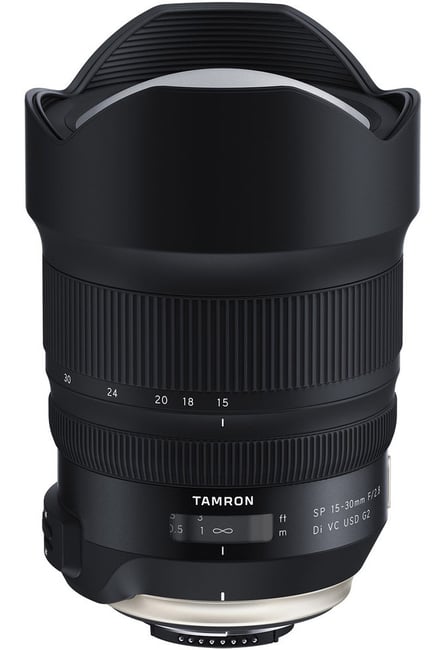
The Tamron SP 15-30mm f/2.8 Di VC USD is a wide-angle zoom lens designed for full-frame DSLR cameras. Here are some key features of the Tamron 15-30mm f/2.8 lens:
- Focal Length: The lens covers a focal length range of 15-30mm, providing a versatile ultra-wide to wide-angle zoom capability.
- Constant Aperture: The lens features a constant maximum aperture of f/2.8 throughout the zoom range. This wide aperture allows for excellent low-light performance and the ability to achieve a shallow depth of field when necessary.
- Vibration Compensation (VC): Tamron’s Vibration Compensation technology is integrated into the lens to minimize the impact of camera shake, particularly beneficial when shooting at slower shutter speeds or in low-light conditions.
- XGM (eXpanded Glass Molded Aspherical) and LD (Low Dispersion) Elements: The lens likely incorporates specialized glass elements, such as XGM and LD, to reduce chromatic aberrations and distortions, leading to enhanced image quality.
- eBAND and BBAR Coatings: The lens is likely to have Tamron’s proprietary eBAND (Extended Bandwidth and Angular-Dependency) and BBAR (Broad-Band Anti-Reflection) coatings, which help reduce lens flare and ghosting while improving contrast and color fidelity.
- Ultrasonic Silent Drive (USD): The lens is equipped with Tamron’s Ultrasonic Silent Drive motor for fast, precise, and quiet autofocus performance.
- Internal Focusing (IF): The lens probably features internal focusing, meaning the lens length does not change during focusing. This can be advantageous when using polarizing filters.
- Weather-Sealed Construction: The lens may have weather-sealed construction to protect against dust and moisture, enhancing its durability in challenging shooting conditions.
- Compatibility: The Tamron 15-30mm f/2.8 is designed for various camera mounts, including Canon and Nikon, making it compatible with a range of full-frame DSLR cameras.
Always check for any updates or newer models that may have been released since my last update by referring to Tamron’s official website or consulting with authorized dealers.
17. Sigma 14-24mm f/2.8
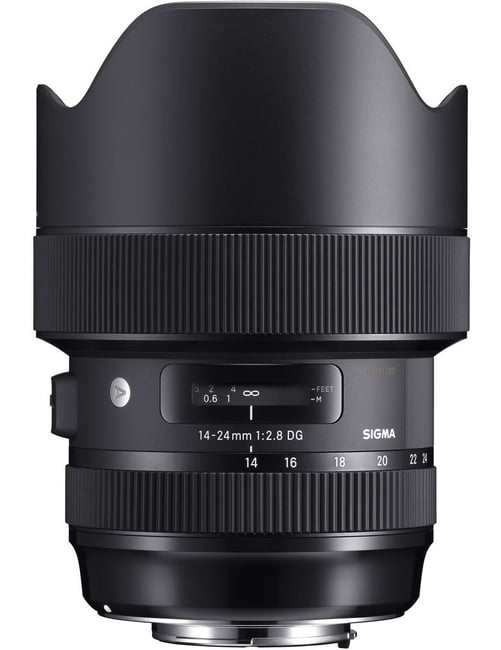
The Sigma 14-24mm f/2.8 DG HSM Art is a wide-angle zoom lens designed for full-frame cameras. Here are some key features of the Sigma 14-24mm f/2.8 lens:
- Focal Length: The lens covers a focal length range of 14-24mm, providing an ultra-wide to wide-angle perspective, making it suitable for landscape, architecture, and astrophotography.
- Constant Aperture: The lens features a constant maximum aperture of f/2.8 throughout the zoom range. This wide aperture allows for excellent low-light performance and depth of field control.
- Optical Design: The lens likely incorporates advanced optical elements, such as FLD (F Low Dispersion) and aspherical elements, to minimize chromatic aberrations, distortions, and provide high image quality.
- Hyper Sonic Motor (HSM): The lens is equipped with Sigma’s HSM for fast, quiet, and accurate autofocus performance. It may also offer full-time manual focus override.
- Front Element Coating: The lens may have a water- and oil-repellent coating on the front element to facilitate easier cleaning and maintenance.
- Weather-Sealed Construction: The lens likely features weather-sealed construction to protect against dust and moisture, making it more durable in challenging shooting conditions.
- Compatibility: The Sigma 14-24mm f/2.8 is available for various camera mounts, including Canon, Nikon, and Sony, making it compatible with a range of full-frame DSLR and mirrorless cameras.
- Built Quality: Sigma’s Art series lenses are known for their robust build quality and attention to optical performance.
- Rear Filter Holder: Some versions of this lens may include a rear filter holder, allowing photographers to use gel filters at the rear of the lens.
As always, it’s recommended to check for any updates or newer models that may have been released since my last update by referring to Sigma’s official website or consulting with authorized dealers.
16. Tokina Opera 16-28mm f/2.8
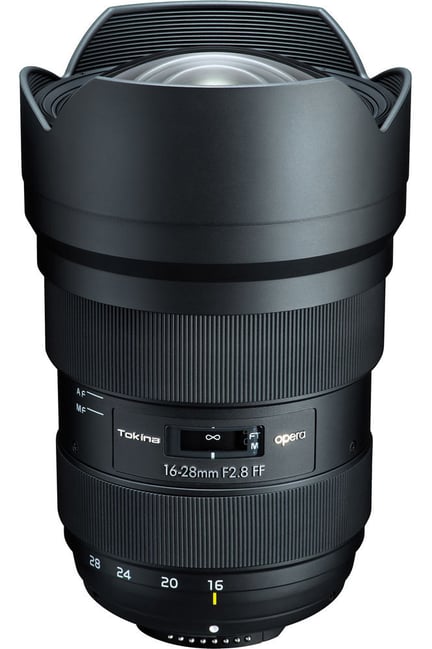
The Tokina Opera 16-28mm f/2.8 FF is a wide-angle zoom lens designed for full-frame cameras. Here are some key features of the Tokina Opera 16-28mm f/2.8 lens:
- Focal Length: The lens covers a focal length range of 16-28mm, providing an ultra-wide to wide-angle perspective, making it suitable for landscape, architecture, and other wide-angle applications.
- Constant Aperture: The lens features a constant maximum aperture of f/2.8 throughout the zoom range. This wide aperture allows for excellent low-light performance and depth of field control.
- Optical Design: The lens likely incorporates specialized glass elements to minimize distortions, chromatic aberrations, and other optical aberrations. Tokina lenses are known for their optical quality.
- Multi-Coating: The lens is likely to have multi-coating on its elements to reduce lens flare and ghosting, enhancing contrast and color accuracy.
- Ring Ultrasonic Motor (Ring USM): The lens may feature a Ring Ultrasonic Motor for fast, accurate, and quiet autofocus performance. Tokina often uses their proprietary motor technology for autofocus.
- One-Touch Focus Clutch Mechanism: Some Tokina lenses include a one-touch focus clutch mechanism that allows for quick switching between autofocus and manual focus by simply sliding the focus ring forward or backward.
- Weather-Sealed Construction: The lens may have weather-sealed construction to protect against dust and moisture, enhancing its durability in challenging shooting conditions.
- Compatibility: The Tokina Opera 16-28mm f/2.8 is designed for various camera mounts, including Canon EF and Nikon F, making it compatible with a range of full-frame DSLR cameras.
As always, it’s recommended to check for any updates or newer models that may have been released since my last update by referring to Tokina’s official website or consulting with authorized dealers.
15. Tamron 17-35mm f/2.8-4

The Tamron SP 17-35mm f/2.8-4 Di OSD (Model A037) is a wide-angle zoom lens designed for full-frame DSLR cameras. Here are some key features of the Tamron 17-35mm f/2.8-4 lens:
- Focal Length: The lens covers a focal length range of 17-35mm, providing a versatile wide to ultra-wide-angle zoom capability suitable for various photography applications, including landscapes and architecture.
- Variable Aperture: The lens features a variable maximum aperture, ranging from f/2.8 at 17mm to f/4 at 35mm. While it may not have a constant aperture, it offers a balance between wide apertures for low-light situations and a more compact design.
- Optical Design: The lens likely incorporates specialized optical elements to reduce aberrations and improve overall image quality.
- Optimized Silent Drive (OSD): The lens may feature Tamron’s Optimized Silent Drive autofocus motor for quick, quiet, and precise autofocus performance.
- Moisture-Resistant Construction: The lens is likely designed with moisture-resistant construction to protect against environmental conditions, enhancing its durability in various shooting situations.
- Internal Focusing (IF): The lens may feature internal focusing, meaning the lens length does not change during focusing. This can be advantageous when using certain filters.
- Compatibility: The Tamron 17-35mm f/2.8-4 is designed for various camera mounts, including Canon and Nikon, making it compatible with a range of full-frame DSLR cameras.
- Lightweight Design: The lens may have a lightweight and compact design, making it a portable option for photographers who prioritize mobility.
As always, it’s recommended to check for any updates or newer models that may have been released since my last update by referring to Tamron’s official website or consulting with authorized dealers.
14. Nikon Z 14-30mm f/4
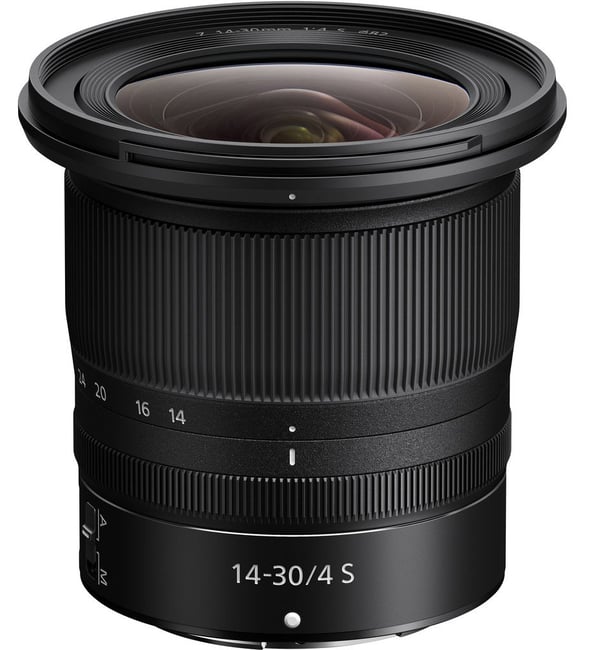
The Nikon Z 14-30mm f/4 lens is an ultra-wide-angle zoom lens designed for Nikon’s Z-mount mirrorless cameras. Here are some key features and information about this lens:
- Focal Length and Aperture:
- Focal Length: 14-30mm
- Maximum Aperture: f/4
- Z-Mount Compatibility:
- The lens is designed specifically for Nikon’s Z-mount mirrorless cameras, such as the Nikon Z6 and Z7.
- Compact and Lightweight Design:
- The 14-30mm f/4 lens is known for its compact and lightweight design, making it a versatile option for photographers who want to maintain portability.
- Filter Compatibility:
- The lens features a unique design that allows the attachment of filters despite its wide-angle nature. This is achieved using a flat front element and a built-in filter holder.
- Image Quality:
- Nikon lenses are generally known for their optical quality, and the 14-30mm f/4 is expected to deliver sharp images with good color reproduction.
- Weather Sealing:
- The lens may feature weather-sealing, which adds durability and allows photographers to use it in various environmental conditions.
- Video Capabilities:
- With its wide-angle focal length and constant f/4 aperture, this lens can be a good choice for videographers, providing flexibility in various shooting scenarios.
- Stepping Motor (STM):
- The lens may incorporate a stepping motor for quiet and smooth autofocus performance, which is beneficial for both photo and video applications.
It’s important to note that specifications and features can be subject to updates or changes, so it’s recommended to check the latest information from Nikon or other reliable sources for the most up-to-date details on the Nikon Z 14-30mm f/4 lens.
13. Nikon 16-35mm f4G VR review
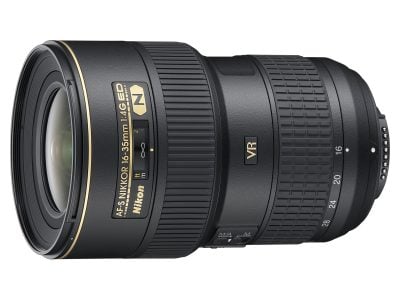
The Nikon AF-S NIKKOR 16-35mm f/4G ED VR is a wide-angle zoom lens designed for Nikon’s FX (full-frame) cameras. Below are key features and a brief review of the lens:
Key Features:
- Focal Length: The lens covers a versatile focal length range of 16-35mm, making it suitable for various photography genres, including landscapes, architecture, and interior photography.
- Vibration Reduction (VR): The inclusion of Nikon’s VR technology provides image stabilization, helping to reduce the impact of camera shake, particularly in low-light situations or when using slower shutter speeds.
- Constant Aperture: The lens has a constant maximum aperture of f/4 across the entire zoom range. While not as wide as some f/2.8 lenses, a constant aperture simplifies exposure control when zooming in and out.
- ED (Extra-Low Dispersion) Glass: The lens features ED glass elements to minimize chromatic aberrations and enhance overall image quality.
- Nano Crystal Coat: Nikon’s Nano Crystal Coat is applied to reduce lens flare and ghosting, contributing to improved contrast and color fidelity.
- Silent Wave Motor (SWM): The lens is equipped with Nikon’s Silent Wave Motor for fast, accurate, and quiet autofocus performance.
- Internal Focusing (IF): The lens likely features internal focusing, meaning the lens length does not change during focusing. This can be beneficial for maintaining balance and using certain filters.
- Weather-Sealed Construction: The lens may have weather-sealed construction to protect against dust and moisture, enhancing its durability in challenging shooting conditions.
- Compatibility: The lens is designed for Nikon’s F-mount, making it compatible with a range of Nikon DSLR cameras, both full-frame (FX) and APS-C (DX).
Review:
The Nikon 16-35mm f/4G VR is generally well-received for its optical performance and versatility. The VR feature is particularly beneficial for handheld shooting in low-light conditions or when using slower shutter speeds. The lens produces sharp images with minimal distortions, and the Nano Crystal Coat helps control lens flare and ghosting.
Photographers appreciate the wide-angle capability of the lens, making it suitable for capturing expansive landscapes and architectural details. The constant f/4 aperture provides a good balance between performance and port
12. Nikon 8-15mm f3.5-4.5 fisheye review
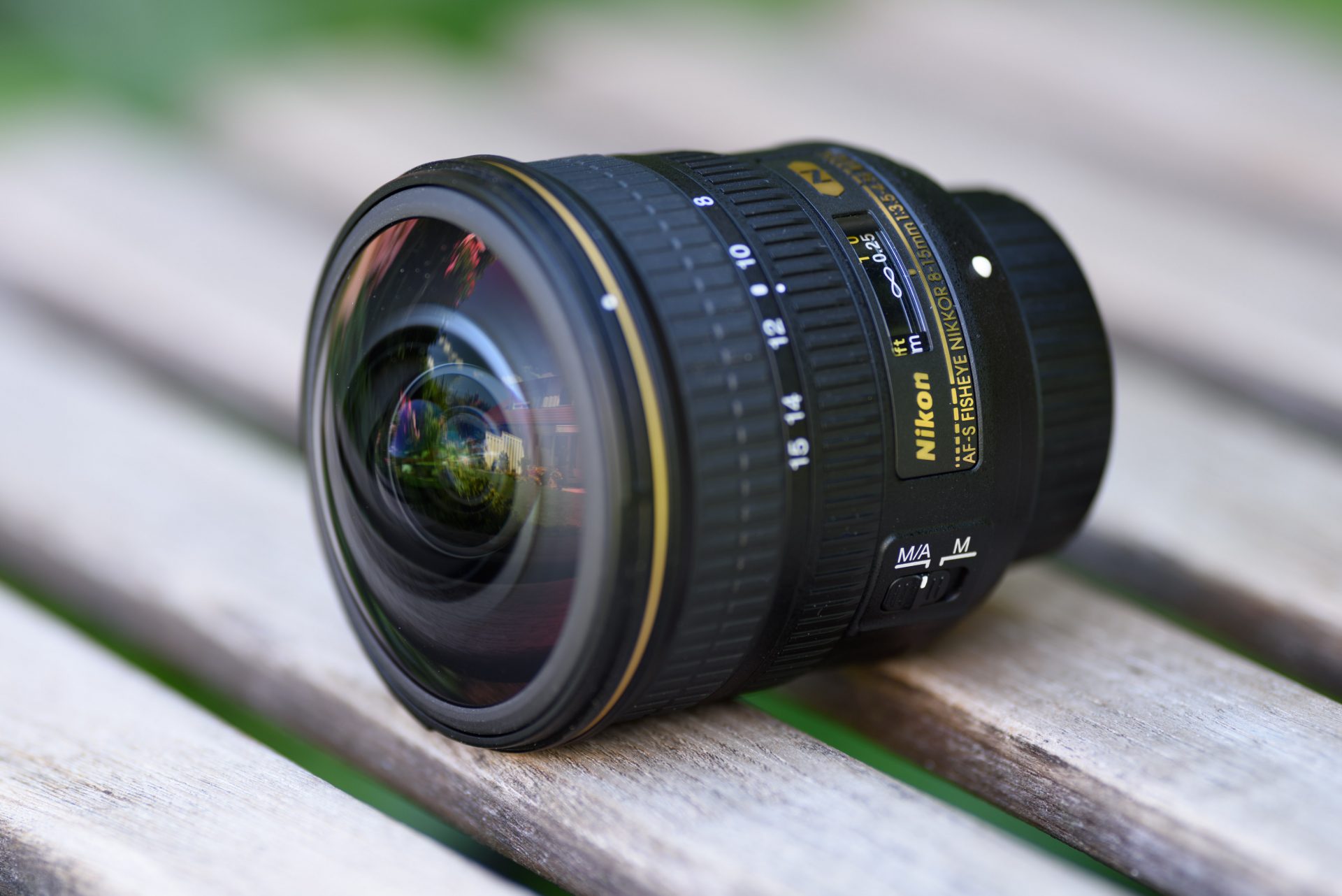
The Nikon AF-S Fisheye NIKKOR 8-15mm f/3.5-4.5E ED is a fisheye zoom lens designed for Nikon FX-format cameras. Here’s a brief review of this lens:
Key Features:
- Focal Length and Aperture:
- Focal Length: 8-15mm
- Maximum Aperture: f/3.5-4.5
- Fisheye Design:
- The lens offers a unique fisheye perspective, capturing an ultra-wide field of view and producing distinctive, curved images.
- Zoom Range:
- The zoom range from 8mm to 15mm provides versatility, allowing photographers to choose between extreme fisheye effects at 8mm or a less pronounced fisheye look at 15mm.
- ED Glass and Aspherical Elements:
- The lens features Extra-Low Dispersion (ED) glass and aspherical elements to control chromatic aberrations and distortions, resulting in improved image quality.
- Nano Crystal Coat:
- Nikon’s Nano Crystal Coat is applied to reduce lens flare and ghosting, enhancing contrast and clarity, especially when shooting in challenging lighting conditions.
- Electromagnetic Diaphragm Mechanism:
- The electromagnetic diaphragm mechanism ensures consistent exposure control during high-speed continuous shooting, providing more precise exposure adjustments.
- Weather Sealing:
- The lens may include weather-sealing to protect against dust and moisture, allowing photographers to use it in various environmental conditions.
- Built-In Lens Hood:
- The lens has a built-in lens hood, contributing to its compact design and helping to minimize lens flare.
- Compatibility:
- The lens is designed for Nikon’s FX-format cameras but can also be used on DX-format cameras, where it will provide a circular fisheye effect at the wide end.
Pros:
- Unique fisheye perspective.
- Versatile zoom range.
- High-quality optics with ED and aspherical elements.
- Nano Crystal Coat for reduced flare and ghosting.
- Electromagnetic diaphragm for consistent exposure.
Cons:
- Fisheye effect may not be suitable for all types of photography.
- Limited to Nikon’s FX-format cameras for optimal performance.
It’s recommended to check for the latest user reviews and expert opinions to get the most current and comprehensive information about the Nikon 8-15mm f/3.5-4.5 fisheye lens, as developments may have occurred since my last update.
11. Nikon 28mm f1.4E review
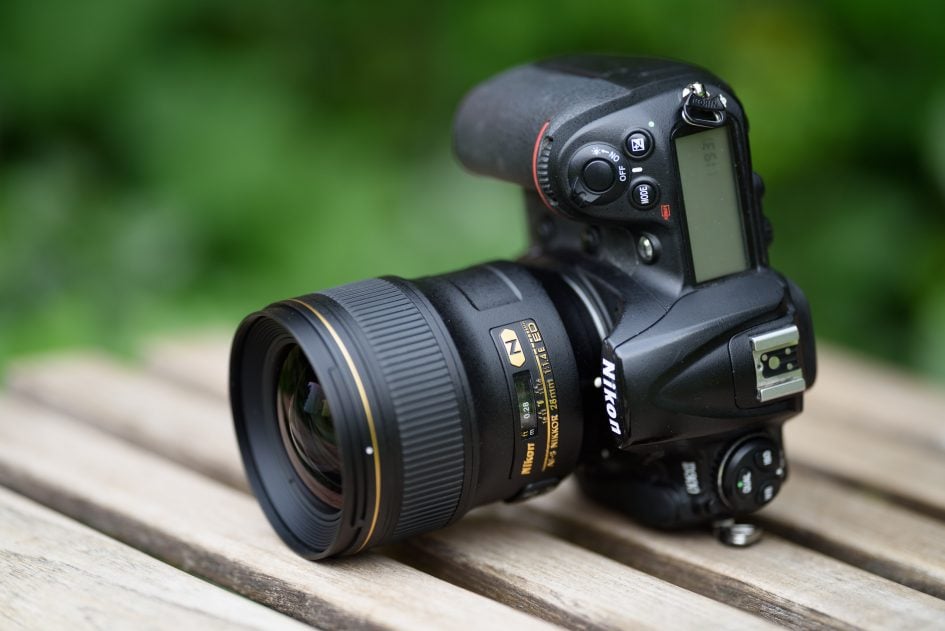
The Nikon AF-S NIKKOR 28mm f/1.4E ED is a wide-angle prime lens designed for Nikon FX-format cameras. Here’s a brief review of this lens:
Key Features:
- Focal Length and Aperture:
- Focal Length: 28mm
- Maximum Aperture: f/1.4
- Wide Aperture:
- The f/1.4 aperture allows for excellent low-light performance and provides the ability to achieve a shallow depth of field for creative effects.
- ED and Aspherical Elements:
- The lens incorporates Extra-Low Dispersion (ED) glass and aspherical lens elements to minimize chromatic aberrations and spherical aberrations, ensuring high image quality.
- Nano Crystal Coat:
- Nikon’s Nano Crystal Coat is applied to reduce lens flare and ghosting, resulting in improved contrast and clarity, especially in challenging lighting conditions.
- Silent Wave Motor (SWM):
- The Silent Wave Motor provides fast, accurate, and quiet autofocus performance, making the lens suitable for both still photography and video recording.
- Weather Sealing:
- The lens is equipped with weather-sealing to protect against dust and moisture, enhancing its durability and allowing photographers to use it in various conditions.
- Rounded Diaphragm Blades:
- The rounded diaphragm blades contribute to producing smooth and pleasing bokeh when shooting at wider apertures.
- Durable Construction:
- The lens is built with high-quality materials and features a durable construction, ensuring its longevity and reliability.
Pros:
- Fast f/1.4 aperture for low-light performance and creative control.
- High-quality optics with ED and aspherical elements.
- Nano Crystal Coat for reduced flare and ghosting.
- Fast and quiet autofocus with the Silent Wave Motor.
- Weather-sealed construction for added durability.
Cons:
- The lens is relatively large and heavy compared to some other prime lenses.
- The price point may be higher compared to other 28mm lenses.
Overall:
The Nikon 28mm f/1.4E is a premium wide-angle prime lens that is well-suited for a variety of photography styles, including landscape, street, and environmental portrait photography. Its wide aperture, high-quality optics, and robust construction make it a versatile choice for professional photographers and enthusiasts looking for top-notch image quality.
As always, it’s advisable to check for the latest user reviews and expert opinions to ensure that this lens meets your specific requirements and expectations, as developments may have occurred since my last update.
10. Sigma 12-24mm f4 Art review
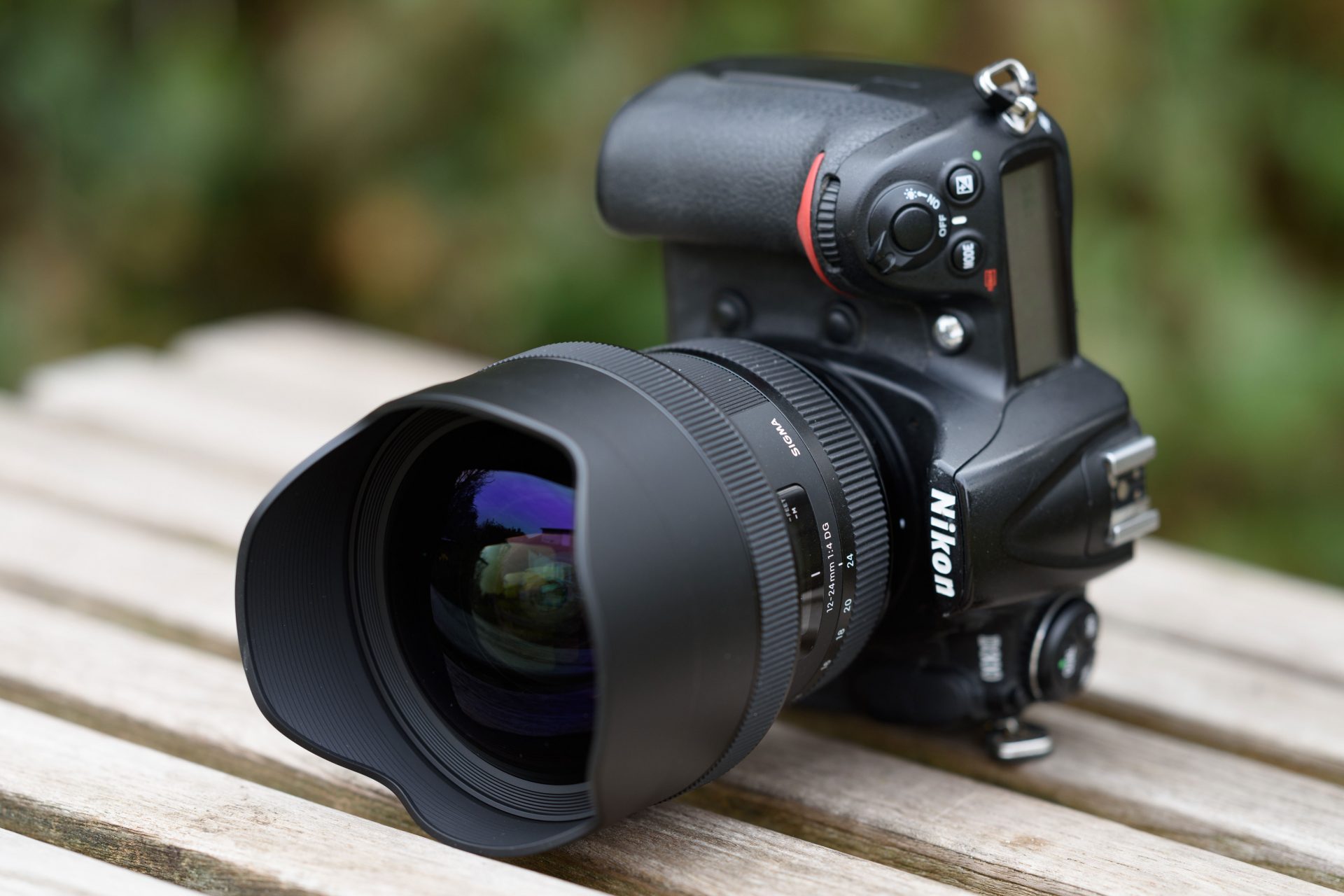
The Sigma 12-24mm f/4 DG HSM Art is an ultra-wide-angle zoom lens designed for full-frame cameras. Here’s a brief review of this lens:
Key Features:
- Focal Length and Aperture:
- Focal Length: 12-24mm
- Maximum Aperture: f/4
- Art Series Design:
- The lens belongs to Sigma’s Art series, known for its emphasis on optical performance and image quality.
- Special Low Dispersion (SLD) and FLD Elements:
- The lens incorporates Special Low Dispersion (SLD) and F Low Dispersion (FLD) glass elements to minimize chromatic aberrations and enhance image clarity.
- Multi-Layer Coating:
- Sigma’s Super Multi-Layer Coating helps reduce lens flare and ghosting, improving contrast and color accuracy.
- Hyper Sonic Motor (HSM):
- The Hyper Sonic Motor provides fast and quiet autofocus performance, making the lens suitable for various shooting situations.
- Full-Frame Compatibility:
- The lens is designed for full-frame cameras but can also be used on APS-C sensor cameras, where it provides an equivalent focal length range.
- Weather-Sealed Construction:
- The lens features a weather-sealed design, providing protection against dust and moisture, which is beneficial for outdoor and challenging shooting conditions.
- Built-in Petal-Type Hood:
- The lens comes with a built-in petal-type hood to help reduce lens flare and protect the front element.
Pros:
- Ultra-wide focal length range, suitable for landscape, architectural, and astrophotography.
- Art series design focusing on optical quality.
- Special Low Dispersion and FLD elements for reduced chromatic aberrations.
- HSM for fast and quiet autofocus.
- Weather-sealed construction for added durability.
Cons:
- The f/4 aperture might not be as fast as some prime lenses, limiting low-light performance and depth of field control.
- The lens is relatively large and heavy, which might impact portability.
Overall:
The Sigma 12-24mm f/4 Art lens is well-regarded for its ultra-wide focal length range, making it suitable for capturing expansive landscapes and architectural scenes. The lens’s emphasis on optical quality, along with features like weather-sealing and a quiet autofocus motor, makes it a versatile choice for photographers looking for a high-performance ultra-wide-angle zoom lens.
As always, it’s advisable to check for the latest user reviews and expert opinions to ensure that this lens aligns with your specific needs and preferences, as developments may have occurred since my last update.
9. Sigma 24-35mm f2 Art review
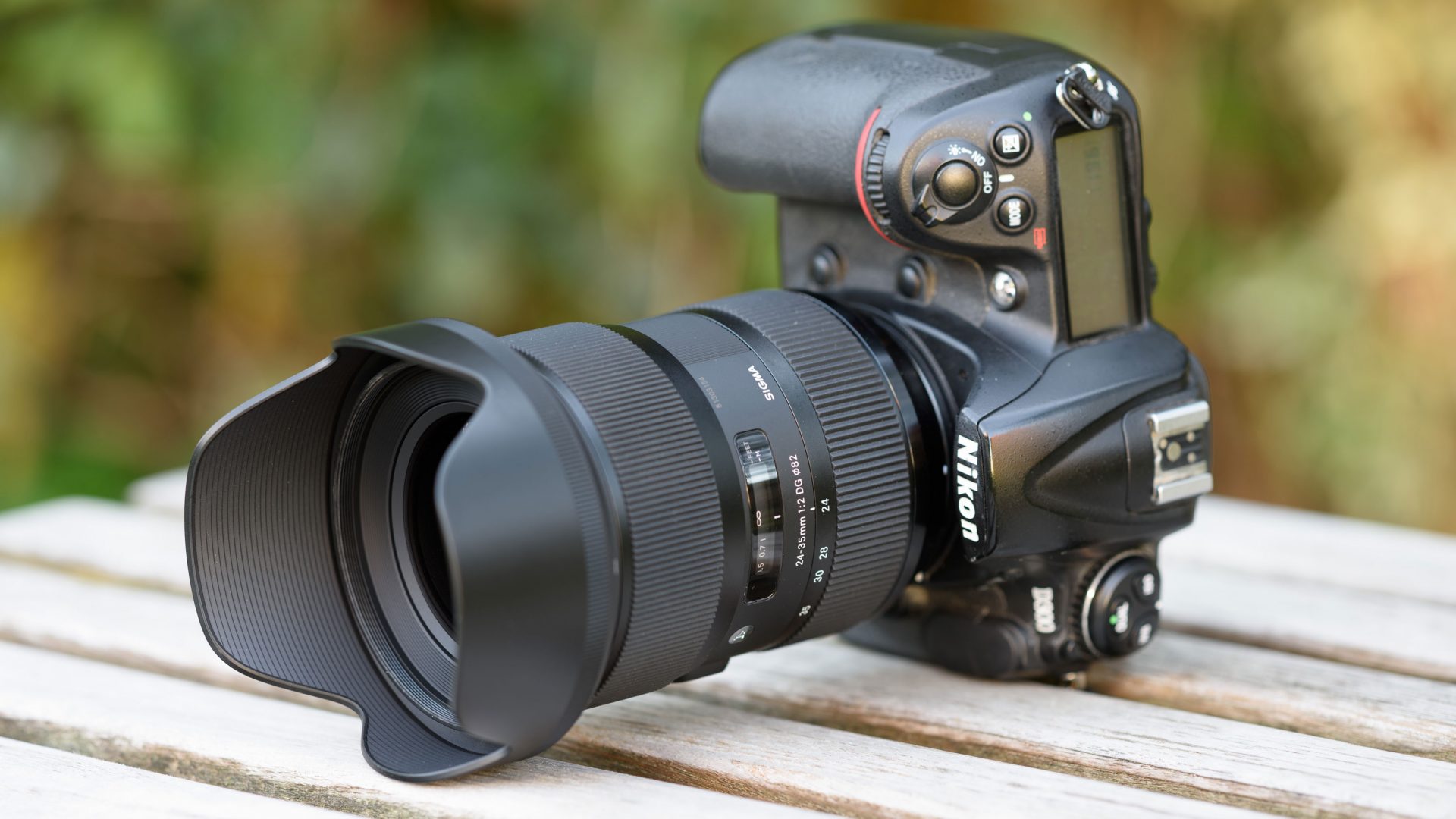
The Sigma 24-35mm f/2 DG HSM Art lens is a unique zoom lens designed for full-frame cameras. Here’s a brief review of this lens:
Key Features:
- Focal Length and Aperture:
- Focal Length: 24-35mm
- Maximum Aperture: f/2
- Art Series Design:
- The lens is part of Sigma’s Art series, which is known for its emphasis on delivering high optical performance and image quality.
- Constant f/2 Aperture:
- The constant f/2 aperture across the zoom range is a distinctive feature, allowing for consistent low-light performance and the ability to achieve a shallow depth of field.
- Special Low Dispersion (SLD) and F Low Dispersion (FLD) Elements:
- The inclusion of SLD and FLD glass elements helps minimize chromatic aberrations, enhancing image sharpness and clarity.
- Hyper Sonic Motor (HSM):
- The Hyper Sonic Motor ensures fast and quiet autofocus, making the lens suitable for various shooting situations.
- Artificially Created Bokeh:
- Sigma has designed the lens to produce attractive bokeh, making it a versatile choice for portrait photography despite being a wide-angle zoom.
- Optical Performance:
- The lens is designed to provide excellent optical performance, capturing sharp and detailed images throughout the zoom range.
- Compatible with Sigma USB Dock:
- Sigma lenses compatible with the USB Dock allow for firmware updates and customization of certain parameters, enhancing the lens’s performance.
Pros:
- Unique zoom range with a wide constant f/2 aperture.
- Art series design emphasizing optical quality.
- SLD and FLD elements for reduced chromatic aberrations.
- Fast and quiet autofocus with the HSM motor.
- Versatile for low-light conditions and creative depth of field control.
Cons:
- The lens is relatively large and heavy, impacting portability.
- Limited zoom range compared to typical zoom lenses.
Overall:
The Sigma 24-35mm f/2 Art lens stands out for its unique combination of a wide zoom range and a bright f/2 aperture. This makes it a versatile choice for photographers who want the flexibility of a zoom lens without compromising on low-light performance and the ability to achieve shallow depth of field. It’s particularly suitable for creative work, including landscape photography, environmental portraits, and low-light shooting scenarios.
As always, for the latest and most detailed information, it’s recommended to check recent user reviews and expert opinions, as developments may have occurred since my last update.
8. Sigma 20mm f1.4 Art review

The Sigma 20mm f/1.4 DG HSM Art lens is a wide-angle prime lens designed for full-frame cameras. Here’s a brief review of this lens:
Key Features:
- Focal Length and Aperture:
- Focal Length: 20mm
- Maximum Aperture: f/1.4
- Art Series Design:
- The lens is part of Sigma’s Art series, which is known for its commitment to delivering high optical performance and image quality.
- Fast f/1.4 Aperture:
- The wide f/1.4 aperture allows for excellent low-light performance, creative depth of field control, and the ability to shoot in challenging lighting conditions.
- Special Low Dispersion (SLD) and F Low Dispersion (FLD) Elements:
- The inclusion of SLD and FLD glass elements helps to minimize chromatic aberrations, resulting in improved image quality and sharpness.
- Super Multi-Layer Coating:
- Sigma’s Super Multi-Layer Coating is applied to reduce flare and ghosting, enhancing contrast and color accuracy.
- Hyper Sonic Motor (HSM):
- The Hyper Sonic Motor ensures fast and quiet autofocus performance, making the lens suitable for both still photography and video recording.
- Floating System:
- The lens features a floating system to adjust the distance between lens elements during focusing, contributing to optimal optical performance at different focusing distances.
- Weather-Sealed Construction:
- The lens is constructed with weather-sealing to protect against dust and moisture, providing durability for outdoor use.
Pros:
- Wide 20mm focal length for versatile wide-angle shooting.
- Extremely bright f/1.4 aperture for low-light performance and creative control.
- Art series design emphasizing optical quality.
- SLD and FLD elements for reduced chromatic aberrations.
- Fast and quiet autofocus with the HSM motor.
- Weather-sealed construction for added durability.
Cons:
- The lens is relatively large and heavy, impacting portability.
- Some users may find the wide aperture results in a large and heavy lens design.
Overall:
The Sigma 20mm f/1.4 Art lens is well-regarded for its combination of a wide-angle focal length and an exceptionally bright aperture, making it a versatile tool for various photographic applications. Whether you are shooting landscapes, astrophotography, or environmental portraits, the lens’s optical quality and wide aperture can be advantageous.
As always, it’s advisable to check for the latest user reviews and expert opinions to ensure that this lens aligns with your specific needs and preferences, as developments may have occurred since my last update.
7. Sigma 24mm f1.4 Art review
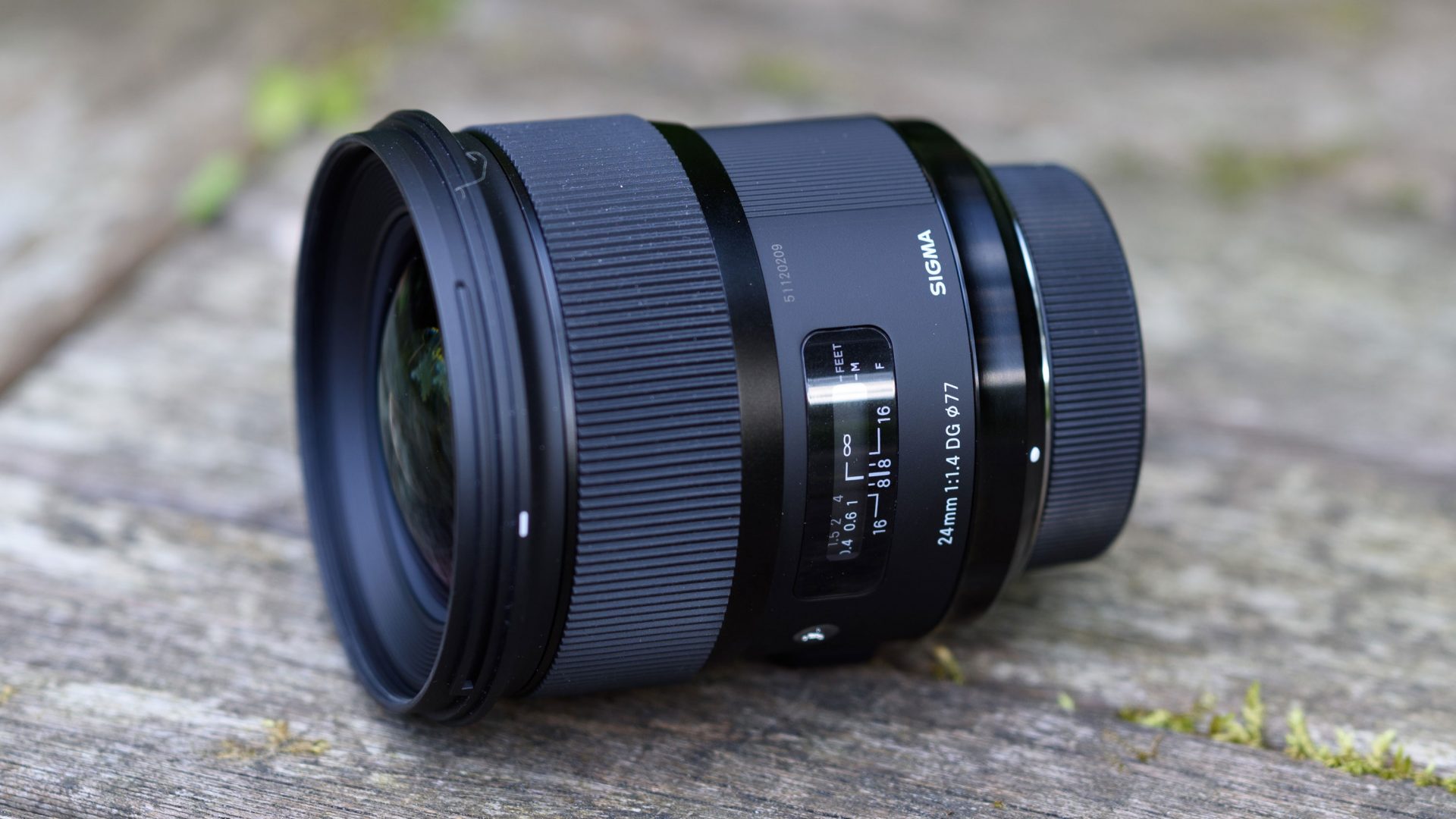
The Sigma 24mm f/1.4 DG HSM Art lens is a wide-angle prime lens designed for full-frame cameras. Here’s a brief review of this lens:
Key Features:
- Focal Length and Aperture:
- Focal Length: 24mm
- Maximum Aperture: f/1.4
- Art Series Design:
- The lens is part of Sigma’s Art series, known for its emphasis on delivering high optical performance and image quality.
- Fast f/1.4 Aperture:
- The wide f/1.4 aperture allows for excellent low-light performance, creative depth of field control, and the ability to capture images in challenging lighting conditions.
- Special Low Dispersion (SLD) and F Low Dispersion (FLD) Elements:
- The inclusion of SLD and FLD glass elements helps to minimize chromatic aberrations, resulting in improved image quality and sharpness.
- Floating System:
- The lens features a floating system that adjusts the distance between lens elements during focusing, contributing to optimal optical performance at different focusing distances.
- Super Multi-Layer Coating:
- Sigma’s Super Multi-Layer Coating is applied to reduce flare and ghosting, enhancing contrast and color accuracy.
- Hyper Sonic Motor (HSM):
- The Hyper Sonic Motor ensures fast and quiet autofocus performance, making the lens suitable for both still photography and video recording.
- Weather-Sealed Construction:
- The lens is constructed with weather-sealing to protect against dust and moisture, providing durability for outdoor use.
Pros:
- Versatile 24mm focal length for various shooting scenarios.
- Extremely bright f/1.4 aperture for low-light performance and creative control.
- Art series design emphasizing optical quality.
- SLD and FLD elements for reduced chromatic aberrations.
- Fast and quiet autofocus with the HSM motor.
- Weather-sealed construction for added durability.
Cons:
- The lens is relatively large and heavy, impacting portability.
- Some users may find the wide aperture results in a large and heavy lens design.
Overall:
The Sigma 24mm f/1.4 Art lens is well-regarded for its combination of a wide-angle focal length and a bright f/1.4 aperture. This makes it a versatile choice for photographers who require excellent low-light performance, creative depth of field control, and high-quality optics. It is suitable for a range of applications, including landscapes, street photography, and environmental portraits.
As always, it’s advisable to check for the latest user reviews and expert opinions to ensure that this lens meets your specific needs, as developments may have occurred since my last update.
6. Tamron 35mm f1.8 VC review
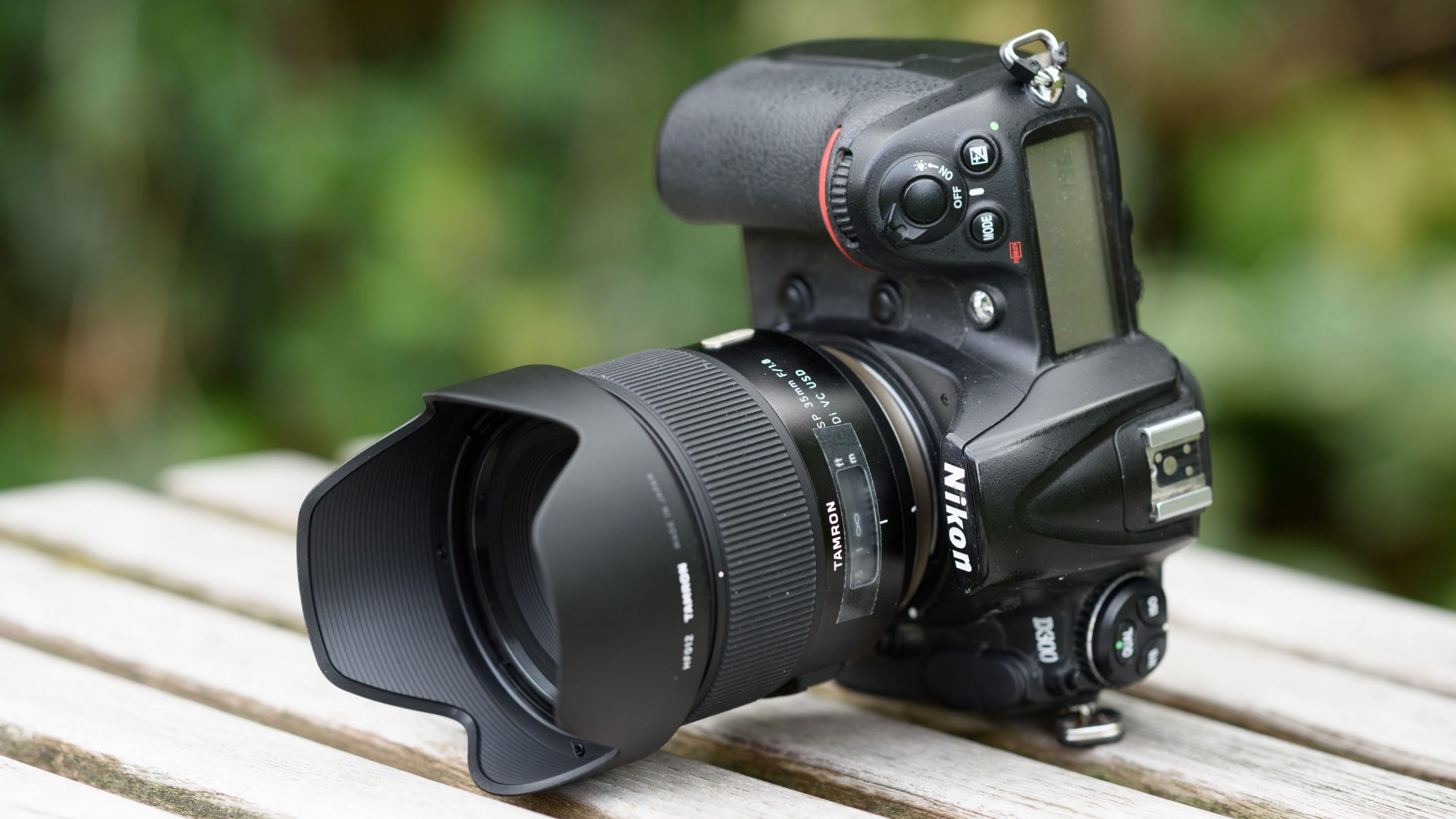
The Tamron SP 35mm f/1.8 Di VC USD lens is a prime lens designed for Canon, Nikon, and Sony DSLRs. Here’s a brief review of this lens:
Key Features:
- Focal Length and Aperture:
- Focal Length: 35mm
- Maximum Aperture: f/1.8
- Vibration Compensation (VC):
- One of the distinctive features of this lens is the built-in Vibration Compensation (VC) mechanism, which helps in reducing the impact of camera shake. This feature is particularly useful for handheld shooting in low-light conditions.
- Ultrasonic Silent Drive (USD):
- The Ultrasonic Silent Drive ensures fast, precise, and quiet autofocus performance, making it suitable for both photography and video recording.
- High-Resolution Optics:
- The lens is designed with high-quality optics to deliver sharp and detailed images. Special lens elements and coatings are used to minimize chromatic aberrations and enhance overall image quality.
- Wide Aperture:
- The wide f/1.8 aperture allows for excellent low-light performance and provides the ability to achieve a shallow depth of field for creative effects.
- Weather-Sealed Construction:
- The lens features moisture-resistant construction, enhancing its durability and making it suitable for use in various environmental conditions.
- Fluorine Coating:
- The front element is coated with a fluorine compound to repel water and oil, making it easier to clean and maintain the lens.
- Compact and Lightweight Design:
- The lens is designed to be compact and lightweight, providing portability for photographers on the go.
Pros:
- Vibration Compensation (VC) for effective image stabilization.
- Wide f/1.8 aperture for low-light performance and creative control.
- High-quality optics with special elements to reduce aberrations.
- Fast and quiet autofocus with the Ultrasonic Silent Drive.
- Weather-sealed construction for added durability.
- Fluorine coating for easier cleaning.
Cons:
- Some users may prefer a wider aperture for even more pronounced background blur.
- Autofocus may not be as fast as some higher-end prime lenses.
Overall:
The Tamron SP 35mm f/1.8 Di VC USD is a versatile lens suitable for various photography genres, including street photography, portraits, and low-light shooting. The inclusion of Vibration Compensation is a notable feature for those who shoot without a tripod, and the wide aperture allows for creative flexibility. The lens’s compact and lightweight design, along with weather-sealing, makes it a practical choice for photographers who value portability and durability.
As always, it’s recommended to check for the latest user reviews and expert opinions for the most up-to-date information on the performance and reliability of the Tamron 35mm f/1.8 VC lens, as developments may have occurred since my last update.
5. Nikon 28mm f1.8G review

The Nikon AF-S NIKKOR 28mm f/1.8G is a wide-angle prime lens designed for Nikon FX-format (full-frame) cameras. Here’s a brief review of this lens:
Key Features:
- Focal Length and Aperture:
- Focal Length: 28mm
- Maximum Aperture: f/1.8
- Wide Aperture:
- The wide f/1.8 aperture allows for excellent low-light performance and provides the ability to achieve a shallow depth of field for creative effects.
- Silent Wave Motor (SWM):
- The lens features Nikon’s Silent Wave Motor for fast, accurate, and quiet autofocus performance, making it suitable for both still photography and video recording.
- Aspherical Elements:
- Aspherical lens elements are incorporated to reduce aberrations and improve image quality, ensuring sharpness and clarity in images.
- Nano Crystal Coat:
- Nikon’s Nano Crystal Coat is applied to reduce lens flare and ghosting, enhancing contrast and color accuracy, especially in challenging lighting conditions.
- Compact and Lightweight Design:
- The lens is designed to be compact and lightweight, making it a portable and versatile option for various shooting situations.
- Weather-Sealed Construction:
- While the lens is not fully weather-sealed, it does feature a rubber gasket around the lens mount to help prevent dust and moisture from entering the camera.
Pros:
- Wide f/1.8 aperture for low-light performance and creative control.
- Silent Wave Motor for fast and quiet autofocus.
- Aspherical elements for improved image quality.
- Nano Crystal Coat for reduced flare and ghosting.
- Compact and lightweight design for portability.
- Versatile focal length for various shooting scenarios.
Cons:
- Not fully weather-sealed.
- Some users might prefer a wider focal length for specific applications.
Overall:
The Nikon 28mm f/1.8G is a versatile prime lens suitable for a range of photography, including landscape, street, and environmental portrait photography. The wide aperture provides flexibility in challenging lighting conditions, and the lens’s optical design contributes to sharp and clear images. The Silent Wave Motor ensures quick and quiet autofocus, making it a practical choice for both photography and video recording.
As always, it’s recommended to check for the latest user reviews and expert opinions for the most up-to-date information on the performance and reliability of the Nikon 28mm f/1.8G lens, as developments may have occurred since my last update.
4. Nikon 14-24mm f2.8G review
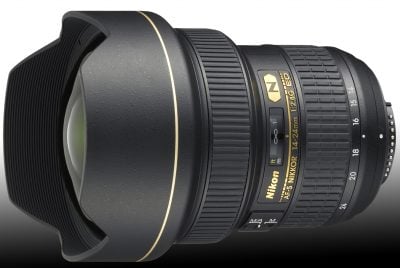
The Nikon 14-24mm f/2.8G is a wide-angle zoom lens known for its excellent optical performance, particularly in low-light conditions. Please note that there might be newer models or updates available after this date.
Here’s a general review based on information available up to 2022:
Key Features:
- Focal Length and Aperture: The lens covers a focal length range from 14mm to 24mm, making it ideal for landscape, architecture, and interior photography. With a constant aperture of f/2.8, it offers good low-light performance and depth of field control.
- Image Quality: The lens is known for its sharpness, even when used wide open. It produces high-quality images with minimal distortion and chromatic aberration. The Nano Crystal Coat technology helps reduce ghosting and flare.
- Build and Durability: The lens features a robust build with a weather-sealed design, making it suitable for use in challenging conditions. The barrel is made of magnesium alloy, contributing to both durability and reduced weight.
- Autofocus: The Silent Wave Motor (SWM) ensures fast and quiet autofocus, and the lens also allows for manual focus override. This is particularly useful for fine-tuning focus in tricky situations.
- Compatibility: The lens is designed for Nikon F-mount cameras. It’s compatible with both full-frame (FX) and cropped-sensor (DX) Nikon DSLRs. However, on DX cameras, the effective focal length will be multiplied, making it equivalent to approximately 21-36mm.
Potential Drawbacks:
- Size and Weight: The lens is relatively large and heavy, which might be a concern for photographers who prioritize portability.
- Bulbous Front Element: The front element of the lens is bulbous and doesn’t accept traditional screw-on filters. Instead, you would need a specialized filter system.
- Price: The lens is relatively expensive, positioning it as a professional-grade lens.
Conclusion:
The Nikon 14-24mm f/2.8G is a highly regarded lens, especially among landscape and architecture photographers who require top-notch optical quality. While it may not be the most lightweight or budget-friendly option, its performance often justifies the investment for serious enthusiasts and professionals in need of a high-quality ultra-wide-angle zoom lens.
Please check for any updates or newer models that may have been released since my last knowledge update in January 2022.
3. Nikon 18-35mm f3.5-4.5G review
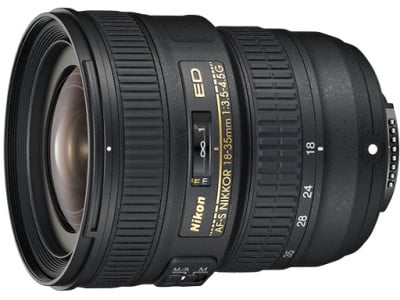
The Nikon 18-35mm f/3.5-4.5G is a wide-angle zoom lens designed for Nikon F-mount cameras. Here’s a review based on the information available up to that point:
Key Features:
- Focal Length and Aperture: The lens provides a versatile focal length range from 18mm to 35mm, making it suitable for various photographic genres, including landscapes, architecture, and general-purpose photography. The variable aperture of f/3.5-4.5 allows for decent low-light performance.
- Image Quality: While not considered a high-end professional lens, the 18-35mm f/3.5-4.5G generally offers good image quality. It provides sharpness across the frame, and the aspherical elements in the lens design help control distortions and aberrations.
- Build and Design: The lens features a compact and lightweight design, making it a convenient option for those who prioritize portability. The construction includes a mix of plastic and metal components, contributing to a balance between durability and weight.
- Silent Wave Motor (SWM): The Silent Wave Motor ensures fast and quiet autofocus, enhancing its usability in various shooting situations. Manual focus override is also available.
- Compatibility: This lens is designed for Nikon F-mount cameras and is compatible with both full-frame (FX) and cropped-sensor (DX) cameras. On DX cameras, the effective focal length will be multiplied, making it equivalent to approximately 27-52.5mm.
Potential Drawbacks:
- Aperture Range: The variable aperture may not be ideal for low-light conditions compared to constant aperture lenses with wider apertures.
- Build Quality: While it is well-constructed for its price range, some users might find that it lacks the premium feel of more expensive lenses due to the use of plastic in its construction.
- Autofocus Speed: While the lens features an SWM for autofocus, it may not be as fast as higher-end Nikon lenses. However, its performance is generally acceptable for most everyday shooting situations.
Conclusion:
The Nikon 18-35mm f/3.5-4.5G is a good choice for photographers looking for a budget-friendly and lightweight wide-angle zoom lens. It provides a decent focal length range and performs well in various shooting scenarios. While it may not have the same build quality or aperture range as more expensive options, it offers a good balance of performance and affordability.
As always, it’s recommended to check for any updates, newer models, or additional user reviews to get the most current and comprehensive information about the lens.
2. Nikon 35mm f1.8G review
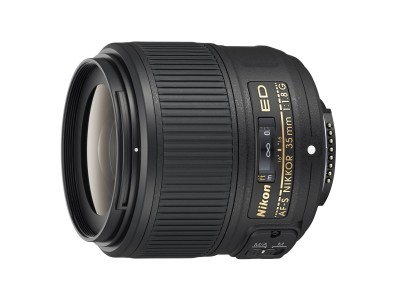
The Nikon 35mm f/1.8G is a popular prime lens known for its wide aperture and versatility, here’s a review based on information available up to that point:
Key Features:
- Focal Length and Aperture: The 35mm focal length on a full-frame camera is often considered a “normal” perspective, making this lens versatile for various genres of photography, including portraits, street photography, and low-light shooting. The wide f/1.8 aperture allows for excellent low-light performance and a shallow depth of field.
- Image Quality: The lens is well-regarded for its sharpness, even when used at its widest aperture. It produces images with good contrast and color rendition. Chromatic aberration and distortion are well-controlled.
- Compact and Lightweight Design: The lens is relatively small and lightweight, making it a convenient choice for everyday use and travel. Its unobtrusive size also makes it suitable for street photography.
- Silent Wave Motor (SWM): The lens features a Silent Wave Motor for fast, accurate, and quiet autofocus. It also allows for manual focus override, providing flexibility to photographers who prefer manual focus in certain situations.
- Aspherical Element: The inclusion of aspherical lens elements contributes to reducing optical aberrations and improving overall image quality.
- Compatibility: The lens is designed for Nikon F-mount cameras and is compatible with both full-frame (FX) and cropped-sensor (DX) cameras. On DX cameras, the effective focal length will be multiplied, making it equivalent to approximately a 50mm lens on a full-frame camera.
Potential Drawbacks:
- Build Quality: While the build quality is generally good, the lens barrel is made of plastic. This contributes to its light weight but might not feel as robust as some higher-end lenses.
- No Vibration Reduction (VR): This lens does not have built-in image stabilization (VR). While the wide aperture helps with low-light situations, photographers may need to pay attention to camera shake, especially in handheld, low-light conditions.
Conclusion:
The Nikon 35mm f/1.8G is a highly praised lens, offering a great balance of performance, affordability, and portability. It’s a favorite among photographers who want a versatile prime lens for everyday use, portraits, and low-light shooting. Its wide aperture allows for creative depth of field effects, making it a solid choice for both amateur and professional photographers.
As always, it’s advisable to check for any updates or newer models released after my last knowledge update in January 2022 to ensure you have the most current information.

1. Nikon 20mm f/1.8
The Nikon AF-S NIKKOR 20mm f/1.8G ED is a wide-angle prime lens designed for Nikon F-mount cameras. Here’s a brief overview of this lens:
Key Features:
- Focal Length and Aperture: The 20mm focal length provides a wide-angle perspective, making it suitable for landscapes, architecture, and astrophotography. The f/1.8 aperture allows for excellent low-light performance and the ability to achieve a shallow depth of field when needed.
- Image Quality: The lens is known for delivering sharp images with good contrast and color reproduction. The inclusion of Extra-low Dispersion (ED) glass elements helps to minimize chromatic aberrations and distortions, contributing to overall image quality.
- Silent Wave Motor (SWM): The lens features Nikon’s Silent Wave Motor for fast, accurate, and quiet autofocus. It also allows for manual focus override, providing flexibility to photographers who prefer manual focus in certain situations.
- Build and Design: The lens has a durable build with weather-sealing to protect against dust and moisture. The lens barrel is constructed using a combination of metal and plastic, providing a good balance between sturdiness and weight.
- Aspherical Elements: Aspherical lens elements are incorporated to reduce spherical aberrations and other optical distortions, contributing to improved image quality.
- Compatibility: The lens is designed for Nikon F-mount cameras, and it is compatible with both full-frame (FX) and cropped-sensor (DX) cameras. On DX cameras, the effective focal length will be multiplied, making it equivalent to approximately a 30mm lens on a full-frame camera.
Potential Drawbacks:
- Price: As a higher-end prime lens with a wide aperture, the Nikon 20mm f/1.8G ED is relatively more expensive compared to some zoom lenses or slower prime lenses.
- Bulbous Front Element: Similar to other wide-angle lenses, the front element of the lens is bulbous, making it incompatible with traditional screw-on filters. Instead, users might need a filter system designed for lenses with a convex front element.
Conclusion:
The Nikon 20mm f/1.8G ED is a well-regarded lens for photographers who require a wide-angle prime with a large aperture. It offers excellent image quality, especially in low-light conditions, making it suitable for a variety of photography genres. The durable build and weather-sealing add to its appeal for those who shoot in different environmental conditions.
As always, it’s recommended to check for any updates or newer models released after my last knowledge update in January 2022 to ensure you have the most current information.
Conclusion
The hardest part for me about picking out a new lens is narrowing down all the options to one that “works.” When there are a lot of angles, it’s harder than normal because even the best answers involve giving something up.
But this list should have helped you a little. It’s hard to go wrong with any of the lenses above, plus many more that didn’t make the list. They’re all great choices. Pick the one that meets your needs the best out of all of them, and then move forward without looking back. It can look like the grass is better on the other side, but any of these lenses could give you equally beautiful pictures.
Finally, when choosing the best wide-angle lens for your Nikon camera, you need to carefully think about your specific needs and tastes. This guide has looked at a number of options so that all types of shooters can find something that works for them, whether they like fast camera speeds, a lot of different settings, or the newest mobile technology. If you have the right wide-angle lens, you can take your shooting to a higher level and find new ways to show yourself and be creative. See the world in a bigger picture way and write down events that will stick with you in your portfolio. Read More
